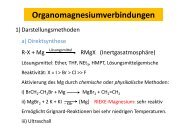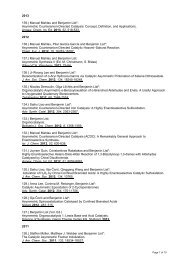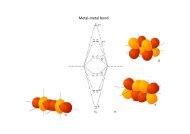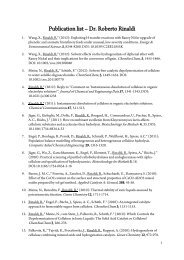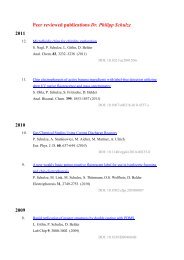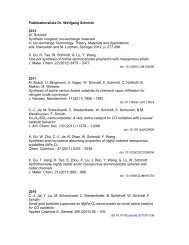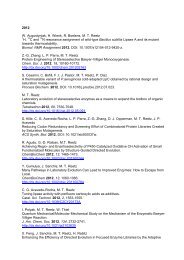5 - Max-Planck-Institut für Kohlenforschung
5 - Max-Planck-Institut für Kohlenforschung
5 - Max-Planck-Institut für Kohlenforschung
Create successful ePaper yourself
Turn your PDF publications into a flip-book with our unique Google optimized e-Paper software.
24<br />
Synthetic Organic Chemistry - Overview<br />
Research in the Department of Synthetic Organic Chemistry<br />
The primary current objective of the Department of Synthetic Organic Chemistry is the<br />
development of new catalytic systems for use in synthetic organic chemistry<br />
(M. T. Reetz, M. W. Haenel, L. J. Gooßen), with additional activities in polymer<br />
chemistry (G. Fink) and coal transformation (M. W. Haenel). Generally, model<br />
reactions are involved, although in other cases specific transformations of real practical<br />
interest are chosen. We attempt to offer new solutions to solving some of the<br />
challenging problems well known in the catalysis community: <strong>Max</strong>imizing efficiency<br />
and ecological viability. This also includes the exploration of totally new approaches<br />
which may not be efficient in the first instance, but which may lay down the foundation<br />
for future development into practical (and perhaps) industrial processes. All of the<br />
results are derived from basic research, which means that interest in understanding any<br />
significant advancements on a molecular basis constitutes an integral part of the various<br />
projects.<br />
The development of new methods in the area of enantioselective catalysis is of great<br />
academic and practical interest worldwide. Since success in this truly difficult endeavor<br />
is based on experience, intuition, knowledge of reaction mechanisms, and the ability to<br />
utilize molecular modeling and other theoretical methods (and of course trial and<br />
error!), many different approaches and ideas need to be discussed and tested. The<br />
<strong>Institut</strong>e is an ideal forum for this type of research. In addition to efforts from this<br />
Department, several groups in the other Departments are likewise involved, leading to a<br />
lively exchange of ideas and in some cases to collaborations. An obvious approach<br />
concerns the development of novel types of chiral ligands for asymmetric transition<br />
metal catalysis, the guiding lines being kinetics and theoretical analyses based on<br />
MM/QM (in collaboration with the Theory Department). Although in the past the<br />
number of steps involved in the synthesis of a given ligand played no role, the focus is<br />
now on cheap chiral starting materials. The maximum number of synthetic steps which<br />
follow should not exceed two or three. Moreover, novel combinatorial approaches are<br />
being developed and applied (M. T. Reetz).<br />
A completely different strategy in asymmetric catalysis concerns directed evolution as a<br />
means to create enantioselective enzymes for use in synthetic organic chemistry<br />
(M. T. Reetz). This way of approaching enantioselectivity is totally independent of any<br />
structural knowledge of the enzyme or of its mode of catalytic action. Instead, it relies<br />
on Darwinistic principles. This approach was pioneered by the Reetz group in the late



